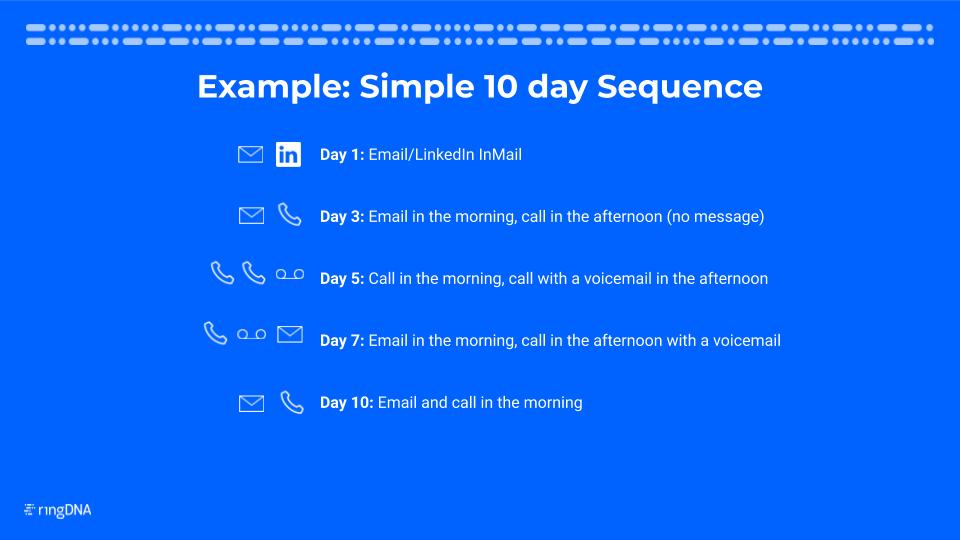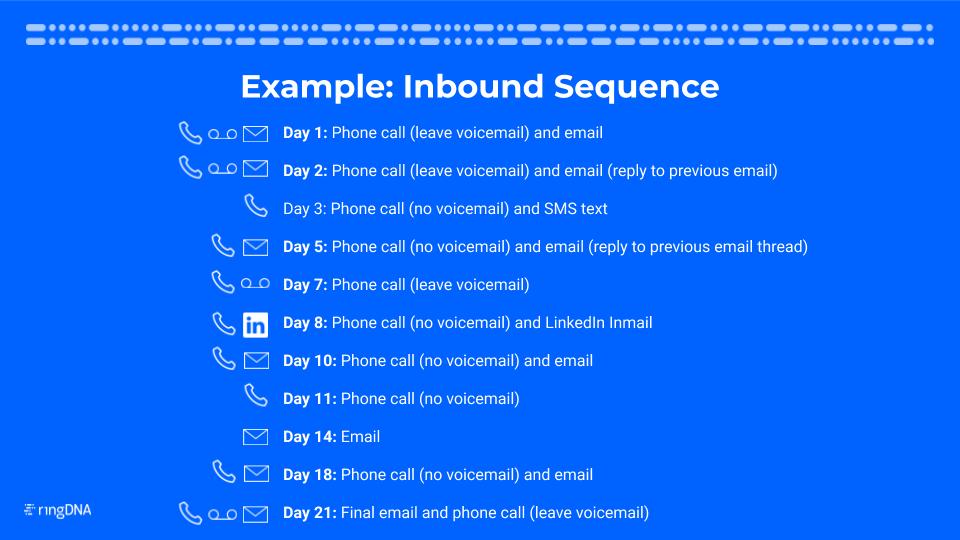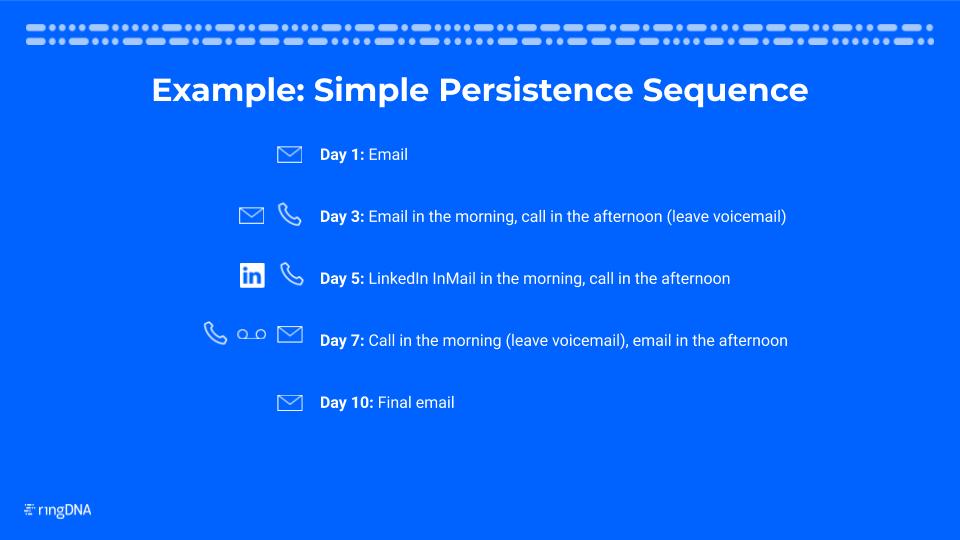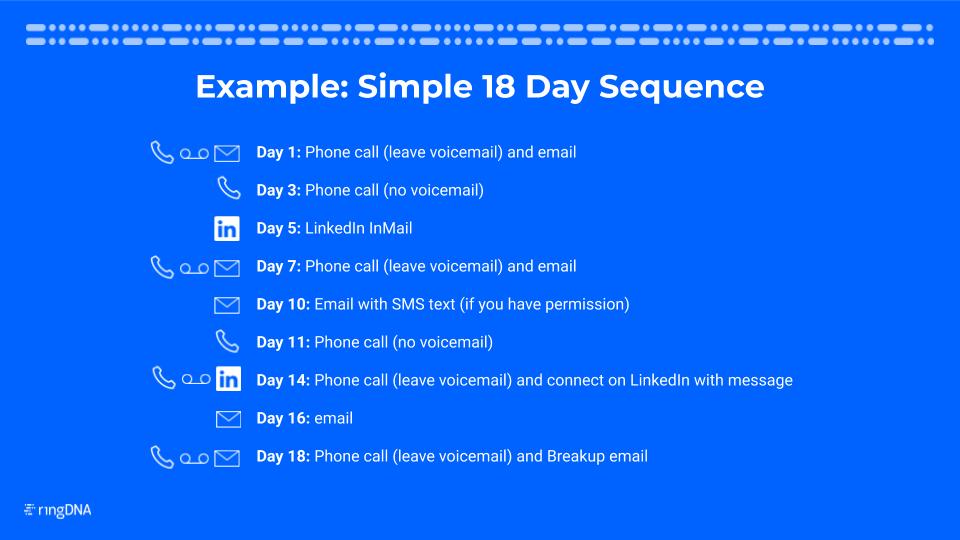What is a Sales Cadence?
A sales cadence, also referred to as a sales sequence, is a scheduled series of sales activities that follow a pre-determined order and agenda.
Cadences are typically oriented towards sales prospecting and include several different activities, such as phone calls, text messages, emails, social media messages, voicemails, and even direct mail. These activities are scheduled in a specific sequence with a set period between each. Reps then follow the cadence and attempt to contact or follow up with prospects within the sales cadence according to the schedule. Sales cadences are usually associated with campaigns, which determine which cadence prospects will receive.
Sales Cadence Example
It could appear as the following:
Day 1: Phone call + email
Day 2: Phone call + social message
Day 3: Nothing
Day 4: Phone call
Day 5: Email
Day 6: Nothing
Day 7: Phone call + SMS
Day 8: Email
Touchpoints
Data shows that on average, a sales rep must make eight or more attempts to reach a prospect. However, the rep doesn’t know the best place to reach them. Furthermore, these touches need to occur at different times of the day, and about activities that both the sales rep and prospect are already performing. Therefore, reps need a way to both schedule and manage their sales activities that allows them to organize their outreach so they can make contact with the right prospect through the right channel at the right time.
Sales cadences automate at least a portion of the sales rep’s job. A cadence tool will automatically schedule activities and remind reps when they need to be done or even perform some outreach, such as a scheduled email, on behalf of a sales rep.
Cadences a standardized manner in which reps prospect, which means that sales managers can capture the data to use in reports to improve the performance of messaging and the cadences themselves.

Sales cadence, sales sequence, and sales automation
Throughout this post, we will be referring to sales cadence, sales sequence, and automation interchangeably. Here is a quick table of contents:
Designing your sequence: the basics
When your cadence begins to create predictable revenue
The power of a sales cadence
Sales cadences ultimately ensure that a sales leader’s playbook is executed perfectly with little room for error. An additional benefit is the ability for sales playbooks to minimize wasted time that plague many teams on things like finding prospects or target lists to reach out to and writing email copy or crafting messaging. A common frustration for sales leaders, especially inside sales managers or sales development managers, is wondering what their reps are focusing on every day, or even trying to help their reps find fresh target lists and strategies for reaching out to new prospects.
Additionally, marketing and sales teams often have disagreements about who should be reaching out to leads and when – sequences help these sales leaders meet any SLAs between departments and ensure speedy response times.
Above all, a sales cadence allows a sales leader to scale a small amount of effort across a large swath of contacts or leads, freeing up time and driving more opportunity pipeline than before.
Scalability
The ability to scale your contact strategy across the organization is critical. Ideally, as your playbook sees success and your product improves, your sales team will grow. New members will join, the department will become bigger, and what was once a small group is now a small army. While this is incredibly exciting, it can also be challenging to determine where you should spend your time, what deals you should help along, and which reps need the most attention. Scaling a pre-planned sales playbook is a great way to create a “brightline” or consistent point of reference that you can hold your individual reps accountable for. It is also an excellent area to test and measure to quickly improve performance across the entire team.
Easy to optimize
Over time, the sequences that you have developed will generate data points. Email click-through rates, call connection rates, opportunity generated ratios, and other KPIs are very useful thresholds for testing and measuring effectiveness. As you start to learn what times of day are best for phone calls, what kind of subject lines work best for your emails, and what patterns of connection are most effective, you can quickly optimize your strategy for better results, providing you a faster pathway to more revenue, and helping you continue to minimize wasted time and energy on activities that don’t matter.
Prioritized effort
A popular statistic reported by Forbes says that salespeople only spend 36% of their time, on average, selling. Unrelated but similar studies have found similar results. Salesforce research found that reps spend 20% of their time doing CRM admin work, 21% of their time researching leads, and 31% of their time searching for or creating content. All of these make sales teams incredibly inefficient and expensive. Sequencing dramatically improves these averages – when employing automation, reps spend less time writing emails, less time logging activities, and less time trying to find the right leads to reach out to.
Designing your sales sequence: the basics
So – you’ve purchased a sales sequencer – now what? There is some work ahead, but with a few quick sprints, you will be able to kick back, relax do some sales coaching, and watch the metrics roll in. There are a few fundamental areas that you will want to focus on as you make early decisions. One thing to keep in mind as you sketch out your strategy is that these decisions are critical. While you of course want to move fast and not get hung up on the details, you also want to be conscious of the fact that these action steps will be applied to hundreds, if not thousands of prospects, and will fundamentally change how your salespeople approach their day-to-day role. Aspects that you will want to consider include the fuel (leads and contacts in Salesforce), steps to include, channels to target, and exit criteria.
Research: How to prepare
Your first priority when it comes to building any automation is wrapping your head around the audience. In this case, you need to think like a marketer and focus 100% of your mental energy on who your buyer personas are, and where your contacts & prospects are coming from. Take full stock of your inbound & outbound contact sources – do you have consistent, predictable inbound lead generation, and defined target lists for your sales development representatives to prospect to? Best practice for building your automation is to make sure you have unique outreach templates for different inbound and outbound sales cadences. The more granular you have time for, the more personalized the outreach will feel, and the more effective it will ultimately be.
Best practices for outbound sales cadences
The most common mistake, as well as the most fatal, for any outbound sales cadences is not following up properly. Most sales development reps do not reach out to leads through the proper channels or at the right time to be effective.
A sales cadence will help your outbound sales team make enough touches, at the right time, through the right channels to engage leads and move them further down the sales process.
Depending on your specific sales organization and the market it operates in, sales outreach should be made through the phone, email, social media, SMS messages, or all of the above. Outreach should also be performed at varying times of the day, but at a regular interval.
The best sales outbound sales cadences have more than 10 touches, use every contact channel available. Some sales leaders have recommended that reps reach out twice a day, every other day for the duration of the 10 touches. Others say to make your calls after 3 PM in the prospect’s local time zone, and to send emails five minutes before or five minutes after the hour for maximum visibility.
Best practices for inbound sales cadences
Inbound sales leads are extremely important to any sales team, as they typically either have marketing spend associated with them, have a higher purchase intent, or both. Therefore, these leads must be capitalized on in the best way possible. Sales cadences allow teams to ensure that inbound leads get the responses they require.
Your inbound sales cadence should be tuned to the source of the inbound lead, and should provide relevant information that adds value.

How many steps should be in a sales cadence & how long should the sequence last
How long your cadence goes on will vary based on the source of your contacts & leads, the industry you work in, and how warm or hot the leads are to begin with. That said, there are a few best practices to consider. TOPO benchmarks advise anywhere between 10 touchpoints to 30, depending on the use case for prospects. This is one of those important decision areas for your business where you need to test & measure what works best in your context. In some hyper-competitive industries, persistence is the name of the game, with up to 15 phone calls to get a connection, in others just a small handful is enough to reach the targets you need to hit. Start with industry standard benchmarks, and tweak and modify from there based on the data you gain.
What is your entrance criteria?
Once you know which leads and contacts you want to begin receiving your sequenced contact strategies, you will need to define when they begin receiving those contact attempts. In most cases, it will be fairly straightforward – if a lead converts on your website, you will immediately sequence them, or if they are in an account target list, you will enroll them with the rest of the list. However, in some business cases there are criteria that are not so linear – for example, if your business operates on a freemium model where users sign up for a free account and after a certain amount of usage need to pay to sign up, you may want to set up triggers to enroll contacts as they hit that threshold or after a certain amount of time. The possibilities are limitless, and really depend on your business model.
When should prospects be removed from a sales cadence?
It is incredibly important to make sure you define clear exit criteria for your leads and contacts to be removed from your automated steps. There is nothing more embarrassing to a salesperson than calling a prospect whom they have already spoken with or having a tone-deaf automated email deploy after a conversation and having to backtrack on the steps taken. A good sequence engine can handle this with ease – typical exit criteria revolve around lead status fields in Salesforce, such as marking a lead as “disqualified” or “nurture”. How your prospects exit a contact sequence will vary based on your business type, but defining, testing, and enforcing these criteria are among your highest priority tasks.
What channels should be steps in your cadence
Many assume that the term sales cadence refers only to automated emails, or even just emails + calls. These channels are certainly still the bread and butter of sales engagement, but other channels are important to fold into the mix as well as communication mediums continue to expand. Incorporating techniques such as social selling, direct mail, and SMS texting are smart plays to make sure you give yourself as many chances as possible to grab your prospect’s attention.
Email is the poster child of automation – marketing automation first popularized the use of scheduled emails in a business context, and sales automation tools have followed in quick succession. Depending on your lead types, you will generally want to schedule 3 or 4 emails at different times of the day, and test the results to see what is effective. Don’t be afraid to schedule an email on a Saturday or a Sunday – more of your prospects are starting to check in or be available on their phones on weekends, and you are more likely to be noticed at these times.
There are two important things to keep in mind as you write your email copy: first, a compelling subject line is super important, but not so important that you should write something extreme or deceiving. Second, personalized fields that automatically insert a prospect’s name, or company name into the email can certainly make them more effective, but you must double and triple-check that these fields are correctly inserted. Nothing will turn your prospects off faster than receiving an email that says “Hi, {{firstname[…” or inserts the wrong name into the email. In that case, you would have been better off with no personalized, dynamic fields at all.
Phone Calls
When it comes to whether or not cold calling is dead, the debate seems to have been decided in favor of the negative. Cold calling is very much alive, with the TOPO sales development benchmark reporting that the number one challenge for sales leaders is live call execution.
Scheduling out a consistent number of outreach methods by phone for your sales reps is the best way to make sure that the prospects get enough touches or leads from your sales reps to ensure that they are not overlooking any potential opportunities or leads that are in a buying cycle. P
hone calls are often, but not always paired with voicemails, but our advice is that your sequence should include at least two phone call + voicemail touches (using the right cold call scripts), because making your target aware of who you are and why you are calling can improve the odds that your next call will be answered.
Voicemail
For some reason, voicemails in sales are a controversial tactic. Many sales teams refuse to leave voicemails, but they do so at their own detriment. Voicemail is one of those very quick ways to get the attention of your prospect, and immediately turns you from an unknown number into a known quantity. If you have value to offer your prospect where they are, you can rest assured that this tactic will yield results. Voicemail efficiency can be supercharged with a voicemail drop solution, which allows you to pre-record your messages and “drop” them after a target doesn’t answer the phone. Marrying this with sequences is another opportunity for you to test and measure your results by scheduling A/B testing your voicemail messages.
SMS text
Texting is another great way to get in front of your customers or quality leads – scheduling your text messages in your sales cadences is a fantastic thing to do, however, you must be cognizant of the laws around text messaging. Texting, unlike emails and phone calls, is one of those channels where you do need an opt-in and some form of permission before you reach out. That means don’t schedule your text messages as the first step in your automation unless the recipient is an inbound lead who has opted in on some sort of web form.
LinkedIn connection requests
LinkedIn connection requests are probably one of the best values in sales engagement right now – not only can you add a target to your personal network and get a little bit of insight on who they are if they have been active on the platform, but you can also add a personal message at no additional cost. We highly recommend that you add these sales actions to your automated sequence.
LinkedIn InMail
Sending LinkedIn InMails as part of your sales cadence is a great tactic as well if you pay for a subscription to LinkedIn Sales Navigator. This tactic gives you some additional customizability, such as ensuring that the message is only delivered once your prospect is logged in to LinkedIn, and also shows up in a different part of the app so it is less likely to be ignored if your prospect is flooded with connection requests.
Other social media
Twitter, Facebook, Instagram, and other emerging channels such as TikTok are certainly worthy actions to schedule out in a sequence, but also may take some additional attention to really be effective. While you could just schedule out something like “follow on Twitter” and leave it at that, these channels are becoming noisier and noisier, making social selling here more and more difficult. LinkedIn is a more scalable channel if that is the approach you have in mind, but a creative, well timed reply Tweet or Instagram comment can yield dividends that other channels cannot. Depending on your business type, scheduling these actions out in your cadence as optional may be the best approach.
Direct mail
Physical mail used to be so over-utilized that it lost effectiveness, but as most strategies have moved 100% digital, in recent years direct mail has come roaring back as a serious marketing channel due to under-utilization. Generally, if you are executing a direct mail campaign, it is best executed as a larger initiative with an individual contact cadence centering around the delivery date of a direct mailer. Scheduled sequences guarantee a direct mail campaign’s success, and make sure that sales teams are calling warmer leads with a reason to reach out instead of pure cold outreach.
Video
Another great way to show your targets that you care about earning their business and are also a real human being is recording a personalized video. This is best left for the highest value prospects as it is not very scalable, but a creative, personable video can make the difference between a cold prospect and an opportunity in the pipeline. Video is a richer communication medium than any of the other channels listed out in this article, but it is not truly its own delivery mechanism. If you are going to be recording a custom prospect video, you will still be delivering it via a scheduled email or text message.
How to maintain the sequence
After you’ve spent meticulous time planning and developing your cadence, your top priority is building and maintaining buy-in from your sales team in faithfully executing the plan. Some steps, like automated emails, require little or no rep involvement and will happen on their own, but many of them, especially phone calls, demand rep participation.
You can take 4 steps to ensure that their participation and enthusiasm for the program doesn’t wane:
- A kickoff meeting: get your entire team into a room with a simple slide that lays out the steps and why each one follows the other. Don’t bore the team with long explanations, but use this opportunity to help them understand why this automation plan is in the works.
- A single view for a streamlined workflow: one of the biggest mistakes in building out automation rules is making reps jump between screens to execute across the planned schedule, or making the team remember every individual cadence plan and requiring them to hop between the CRM, their dialer, and the cadence tool. Utilize a tool that lives within the CRM, and make sure it has a single view that the salesperson never has to leave and spends less time searching for target lists or trying to find the right sequences.
- Loop the team in on the results: as the touch patterns begin to generate data points, present them to the team and show them what changes you are making to maintain effectiveness.
- Listen to the team’s feedback: while we don’t advise building sequences by consensus, we do advise listening and considering your team’s feedback on the sequence’s performance. While your plan certainly has the last word, the team can often have useful insights into what is and is not working, and they will feel more of a sense of ownership of the strategies they are executing if they feel heard.
How to track your sales cadence results
So – you are done building, you’ve trained the team, and it has been in production for several weeks. That means some meaningful data will start to accrue and results will be coming in that allow you to begin to make adjustments.
Some critical data points to watch early on are your email subject lines (email open rates) and your call pick up rates (call to connect ratio). These are the easiest variables to tune and test over time, allowing you to build up some data on what your audience responds to. For example, try some simple tests such as – comparing using data points in subject lines (i.e. Customers in the financial industry saw 450% growth) or comparing scheduled calls in the morning vs. calls in the afternoon. Cadence data over time should give you a very clear picture of if variables like this matter to your targets.
How to manage a sales team using a sequence
At this point you must be thinking – if my reps all know what to do every day and all I have to do is test and measure, what do I do as a sales manager? At this point, your time should be freed up to focus on pipeline and sales coaching. Ideally, calls made from sequences will be recorded, and your AI tool like ConversationAI can surface which ones need coaching and where challenges in conversations occur across your cadences. If you own a team of account executives and manage deals across the marketing funnel.
When your cadence begins to create predictable revenue
With all of the pieces working in tandem – a complete sequence built, a sales team executing on that cadence reliably, metrics rolling in that you are drawing on to modify your automations and find the perfect outcomes, you will notice a sea change in opportunity creation and closed revenue. The beauty of this structure is that it allows you to forecast much more reliably than you were before based on lead volumes. For most sales teams who have yet to adopt sales cadencing, sales response to lead sources and touches on target lists were unpredictable and difficult to define. Now, you have the tools on hand to make judgement calls about how many of your leads will turn into opportunities, how many of those opportunities will close, and how your cadences are turning things around for the better with your sales process.
Appendix: Effective sales cadence examples
If you are looking for some more guidelines on sales cadences, we put together a few more examples:


